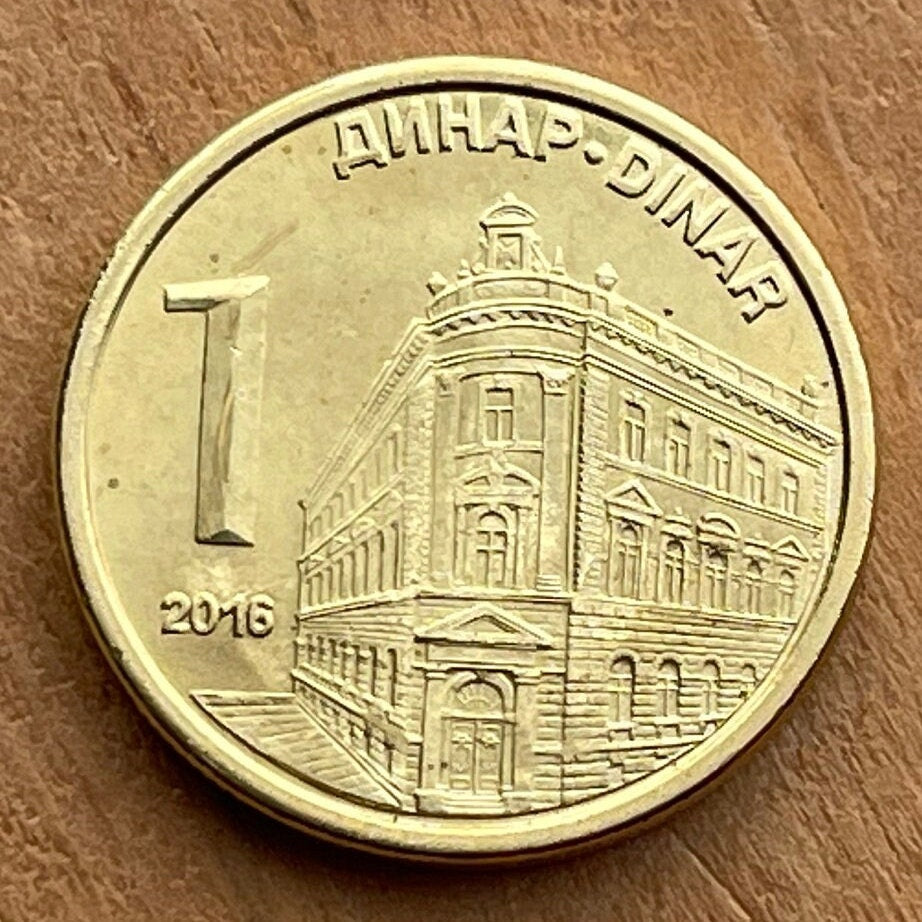elemintalshop
Privileged National Bank Building 1 Dinar Serbia Authentic Coin Money for Jewelry and Craft Making
Privileged National Bank Building 1 Dinar Serbia Authentic Coin Money for Jewelry and Craft Making
Couldn't load pickup availability
Privileged National Bank Building 1 Dinar Serbia Authentic Coin Money for Jewelry and Craft Making (Belgrade)
Reverse: National Bank of Serbia building in Belgrade, with the numerical value above the date to the left
Scripts: Cyrillic, Latin
Lettering: ДИНАР-DINAR
1
Translation: Dinar Dinar
1
Obverse: Serbian coat of arms (with the flat bottom of the top crown)
Scripts: Cyrillic, Latin
Lettering: РЕПУБЛИКА СРБИJА-REPUBLIKA SRBIJA
•НБС-NBS•
Translation: Republic of Serbia - Republic of Serbia
NBS - NBS (National Bank of Serbia)
Edge: 5 reeded segments with 14 reeds each
Features
Issuer Serbia
Period Republic (2006-date)
Type Standard circulation coin
Years 2011-2020
Value 1 Dinar
1 RSD = USD 0.0096
Currency Dinar (2003-date)
Composition Plated steel (brass plating over copper plating)
Weight 4.2 g
Diameter 20 mm
Thickness 2.0 mm
Shape Round
Technique Milled
Orientation Medal alignment ↑↑
Number N# 33449
References KM# 54, Schön# 203
Wikipedia:
The establishment of the Privileged National Bank of the Kingdom of Serbia was a long process consequent on the development of the economy, currency and other financial institutions, as well as the needs of economic and political emancipation of the Kingdom of Serbia. The Bank was formally launched after the adoption of the Law on the National Bank, 12 December 1882, which was confirmed by king Milan Obrenovic on 6 January 1883. Under this law, the Bank was established as a privileged institution (for the next 25 years in the form of a joint stock company), with an initial capital of 20 million dinara, and it was envisaged that its activities would be conducted under the control of the state. Officially, the Bank began operations on 1 June 1884. On that date, the bank leased space taken in Knez Mihajlo no. 38 (now No. 50), at the house of Hristina Kumanudi.
Construction of the building
As its temporary accommodation was inadequate, land was purchased for the construction of a new building in 1886 on the corner of Dubrovacka and Prince Lazar streets, in Belgrade.
In 1887, a draft plan for the new building was adopted, drawn up by two architects employed in the Ministry of Construction. However, the Board of Directors decided to assign project development to Konstantin Jovanović, then already affirmed architect, and son of a lithographer Anastas Jovanović. The Bank project was also his first job in Belgrade. Construction of the building was entrusted to contractors Jirasek and Kraus from Szeged. The work lasted from 1889 until its official completion on 15 March 1890. The importance of the new building was reflected in the award to Konstantin A. Jovanović in 1890 of the Order of St. Sava, class III. The bank's report for 1890 said: "...the Bank has a house of which she can be proud of, as can our capital, which she serves to ornament". Great credit goes to architect Kosta Jovanović who developed the plans and under whose supervision the building was constructed.
After World War I, the Privileged National Bank of the Kingdom of Serbia became the National Bank of the Kingdom of Serbs, Croats and Slovenes. Between 1922–25, the bank building was extended to cater for its space requirements, to fill the entire area of the city block, in the form of an irregular pentagon. Jovanović again carried out the extension, in a style consistent with the older part of the building. It is a closed block with an internal atrium courtyard, and has been preserved to date. Jovanović modelled the building stylistically on the architecture of late-Renaissance palaces of 16th-century Italy. It also appears to be influenced by Jovanović' professor and prominent Viennese architect Gottfried Semper.
Architecture
Jovanović's immediate models were Palazzo Farnese in Rome, designed by Antonio da Sangallo the Younger and Michelangelo (1513, and 1534–46), and Semper's mid-19th-century Oppenheim Palace in Dresden.
******
Wikipedia:
The official description of the greater coat of arms of Serbia is "The greater coat of arms is a red shield, on it between two golden fleurs-de-lys in base, a double-headed silver eagle, armed gold and with the same tongue and legs, with a red shield on the chest, on which is a silver cross between four firesteels with their backs turned to the pale of the cross. The shield is crowned with a golden crown and surrounded with a mantle embroidered with gold, decorated with golden fringes, tied with a golden rope with tassels of the same, lined with ermine and crowned with a golden crown."
The principal field stands for the Serbian state. It consists of a white double-headed eagle on a red shield; its body and wings in white, and tongues, beaks, legs and claws in gold, between two golden fleur-de-lis. The inescutcheon stands for the Serbian nation; in a red shield, a cross in the midst of four firesteels.
The design on the inescutcheon has been used by Serbian states and the Serbian church since the Middle Ages. The four shapes around the central cross are a stylized form of letters, as explained above.
Although Serbia is now a republic, the coat of arms features monarchist imagery like the royal crown of the former Serbian monarchy, and the ermine mantle, which is often present on the coats of arms of many European monarchies.
Share




















